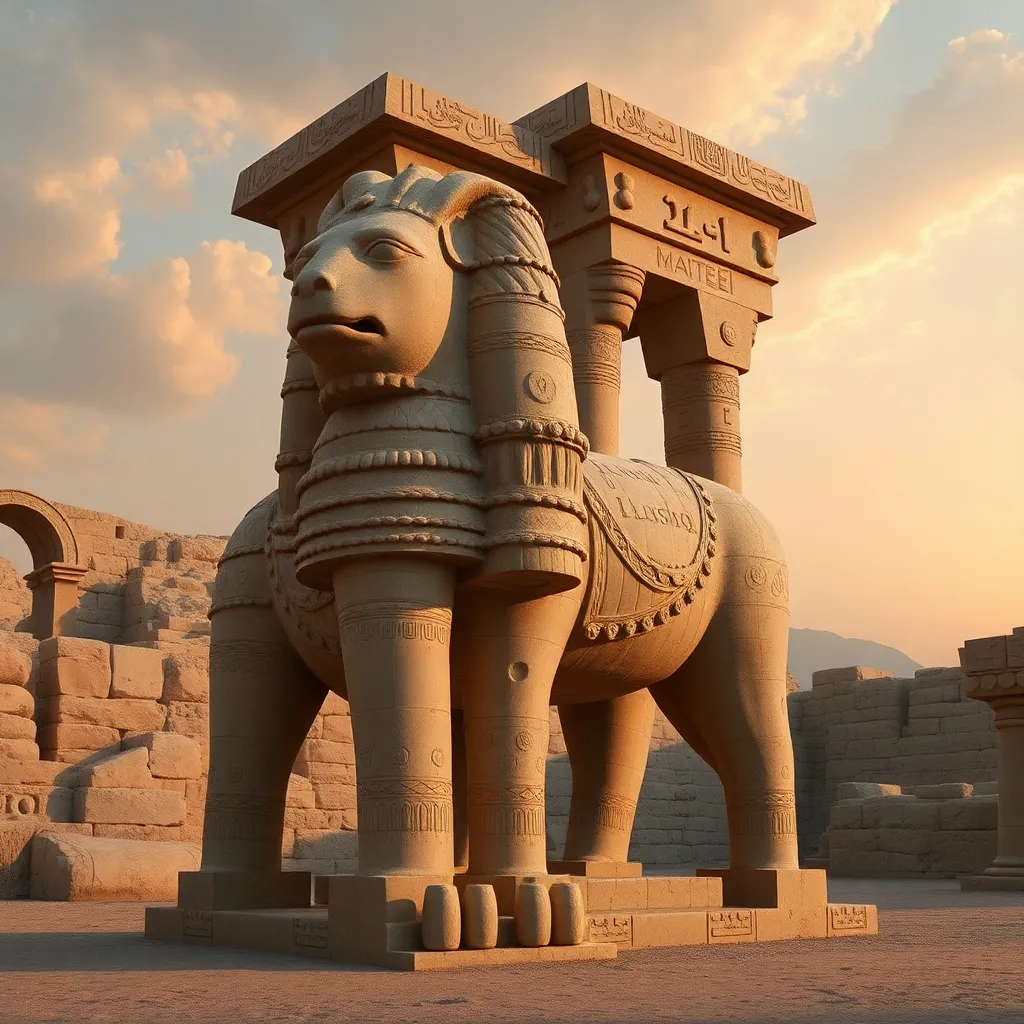The Lamassu in the Levant: Exploring its Role in Ancient Near Eastern Culture
I. Introduction
The Lamassu is a mythological creature with the body of a bull or lion, the wings of an eagle, and the head of a human. These imposing figures served as protective deities in the ancient Near East, particularly in Assyrian and Babylonian cultures. The significance of the Lamassu extends beyond mere decoration; it played a crucial role in the cultural and religious life of the people in the Levant. This article will explore the origins, characteristics, architectural importance, and cultural implications of the Lamassu in the Levant region.
II. Origins and Historical Context
The origins of the Lamassu can be traced back to ancient Mesopotamia, where early representations served both practical and symbolic purposes. These figures were often placed at the entrances of palaces and temples, signifying a boundary between the earthly and divine realms.
A. Early representations and cultural significance
The earliest known representations of Lamassu date back to the Akkadian period around 2300 BCE. They were believed to offer protection against evil spirits and were a symbol of strength and power.
B. The emergence of Lamassu in Assyrian and Babylonian art
As Assyrian and Babylonian cultures flourished, the Lamassu became more prominent in their art. These sculptures were intricately carved and often depicted with elaborate details, emphasizing their divine nature.
C. Influence of Mesopotamian culture on the Levant
The cultural influence of Mesopotamia spread to the Levant, where local artists adopted and adapted the Lamassu form, integrating it into their own cultural contexts. This adaptation reflects the interconnectedness of ancient civilizations in the Near East.
III. Physical Characteristics and Symbolism
The Lamassu is characterized by its unique and striking features, which contribute to its symbolic meanings.
A. Description of the Lamassu’s features
- Human head: Represents intelligence and wisdom.
- Wings: Symbolize divinity and the ability to transcend earthly limitations.
- Body of a bull or lion: Signifies strength, power, and protection.
B. Symbolic meanings associated with Lamassu
The Lamassu was not merely an artistic creation but also a powerful symbol. It represented:
- Protection: Guarding sacred spaces against malevolent forces.
- Power: Reflecting the authority of kings and gods.
- Divinity: Serving as a bridge between the human and divine realms.
C. Variations in artistic representation across different cultures
While the core characteristics of the Lamassu remained consistent, variations emerged in different cultures. For example, in some Levantine representations, the Lamassu may have a more stylized appearance, reflecting local artistic traditions.
IV. Architectural Significance
The Lamassu played a significant role in the architecture of ancient Near Eastern temples and palaces.
A. Role of Lamassu in temple and palace architecture
Lamassu sculptures were typically placed at entrances to important structures, serving as guardians that welcomed visitors while warding off any threats. Their placement was strategic, emphasizing the transition from the mundane to the sacred.
B. Examples of notable Lamassu sculptures in the Levant
Some noteworthy examples of Lamassu in the Levant include:
- The Lamassu from the Palace of Sargon II at Dur-Sharrukin.
- The Lamassu sculptures found in the ruins of Nineveh.
- Various representations in the ancient city of Palmyra.
C. Function as guardians and threshold figures
The Lamassu served as threshold figures, marking the boundary between the human world and the divine. Their imposing presence was intended to instill awe and respect in those who approached sacred spaces.
V. Cultural and Religious Implications
The Lamassu is deeply intertwined with the mythology and religious practices of the ancient Near East.
A. Lamassu in the context of Near Eastern mythology
In Near Eastern mythology, the Lamassu was often associated with various deities and was considered a protector of the home and community. Its presence in art and architecture indicates its importance in daily life.
B. Relationship with other deities and spiritual beliefs in the Levant
The Lamassu was often linked with other protective deities, reflecting a complex spiritual landscape where different gods and goddesses coexisted.
C. The Lamassu’s role in rituals and public life
These figures were likely involved in various public rituals, serving as focal points during ceremonies that reinforced social and religious hierarchies.
VI. Historical Transformations and Adaptations
Over time, the depiction and significance of the Lamassu evolved in response to cultural and political changes.
A. Changes in the depiction of Lamassu over time
As cultures merged and adapted, the Lamassu’s representation became more varied, reflecting changing artistic styles and religious beliefs.
B. Influence of conquest and cultural exchange on Lamassu representations
Conquests by empires such as the Persians and Greeks led to the integration of new artistic elements into Lamassu representations, showcasing a blend of styles and traditions.
C. The legacy of Lamassu in later periods and cultures
The legacy of the Lamassu can be seen in various subsequent cultures, influencing art and architecture long after the decline of the ancient Near Eastern civilizations.
VII. Archaeological Discoveries and Interpretations
Modern archaeology has unveiled numerous Lamassu sculptures, providing insights into their historical context and significance.
A. Key archaeological sites featuring Lamassu
Some significant archaeological sites that have yielded Lamassu figures include:
- Dur-Sharrukin (Khorsabad)
- Nineveh
- Palmyra
B. Methods of study and interpretation by modern archaeologists
Researchers employ various methods, including excavation, analysis of inscriptions, and comparative studies, to interpret the role of Lamassu in ancient societies.
C. Ongoing debates and discoveries regarding Lamassu’s role
Ongoing archaeological work continues to uncover new findings, leading to debates about the Lamassu’s functions and meanings in different contexts.
VIII. Conclusion
The Lamassu holds a significant place in the cultural and religious landscape of the Levant. Its role as a protective guardian in architecture and its symbolic meanings reflect the complexities of ancient Near Eastern societies. As we continue to uncover and study these magnificent figures, the Lamassu’s enduring legacy remains evident in contemporary culture and art.
Future research and exploration will undoubtedly shed more light on the Lamassu, enhancing our understanding of its importance in ancient civilizations and its lasting impact on modern societies.



